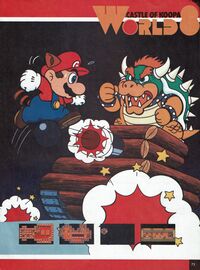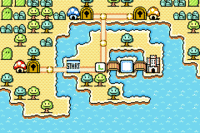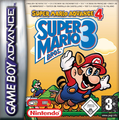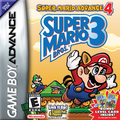Super Mario Bros. 3
Template:Articleabout Template:Infobox Super Mario Bros. 3 is a platform adventure game for the Famicom and NES and is the third installment in the Super Mario Bros. series (forth in Japan) It was released in Japan on October 23, 1988; in North America on February 9, 1990; and in Europe on August 29, 1991. It was later released in the US on the Wii's Virtual Console on November 5, 2007. It is the sequel to the Japanese version of Super Mario Bros. 2, although outside of Japan, it is considered the sequel to the international Super Mario Bros. 2.
It has been considered as one of the greatest games of all time. Its complexity and challenging levels made it a huge success. In addition to new power ups, it features new moves, items, and enemies. It also features special non-level parts of each world, including Toad Houses, where items can be obtained, and Spade Panels, where lives can be obtained, as well as some secret parts, such as the White Toad House and the Treasure Ship.
Shortly after the release of the game, a cartoon named The Adventures of Super Mario Bros. 3 was made. The cartoon was based on the game but with a different plot. In the cartoons, King Koopa and the Koopalings tried to take over the real world as well, and not only the Mushroom Kingdom. The cartoon series is produced by DIC Entertainment Productions in association with Nintendo.
Story
Bowser has returned to the Mushroom Kingdom and now with the help of his seven Koopaling children, he tries to conquer it again. He sends his Koopalings (Larry, Roy, Lemmy, Wendy, Iggy, Morton, and Ludwig) into seven parts of the Mushroom World to steal the Mushroom Kings' magic wands, and with the wands, transform the Kings into various creatures. Princess Toadstool sends Mario and Luigi to go and stop the Koopalings, and turn the kings back into their normal form. At the end of each world, Mario and Luigi fight one of the Koopalings, and after the match is over, retrieve the wand from the Koopaling to turn the king back to normal. While the brothers are out in their adventure, Bowser kidnaps Princess Toadstool and takes her to his lair in Dark Land. The brothers go to Dark Land and fight Bowser. After defeating Bowser, they save Princess Toadstool and they all return to the Mushroom Kingdom.
Worlds
Grass Land (Larry Koopa)
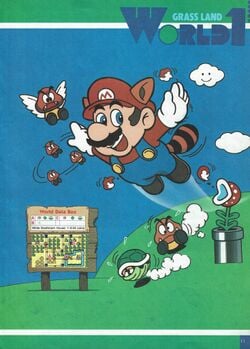
Grass Land is the first world of the game that was attacked by Larry Koopa, who stole the wand of the Grass Land King and turned him into a dog (or a Cobrat from Super Mario Bros. 2 in the remake). The landscape itself is mainly composed of plains, surrounded by hills and even some cliffs in the south. A fortress can be found in the middle of Grass Land, and the king's palace lies to the southeast, surrounded by a circular moat. The enemies Mario encounters here are regular ones, like Goombas, Koopa Troopas and Piranha Plants. The world features a Spade Panel, two Toad Houses and six levels, of which four have to be cleared to reach the king's palace.
Desert Hill (Morton Koopa Jr.)
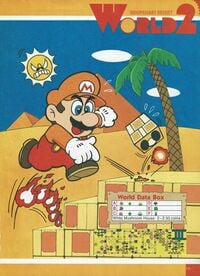
Desert Hill (also known as Desert Land or the Koopahari Desert) is the second world of the game. It is a region within a vast desert, filled with sand, palm trees and some pyramids. A fortress is located in the west part of the desert, and a quicksand field can also be found, as well as a great pyramid that the player needs to traverse in order to reach the kings palace. The king was attacked by Morton Koopa Jr., who turned him into a spider (or a Hoopstar from Super Mario Bros. 2 in the remake). The world features two Spade Panels and three Toad Houses, of which one lies in a secret area behind a rock, that needs to be crushed by a Hammer.The boulder also hides two Fire Bros. which stole the last Warp Whistle. Four of the five levels need to be cleared to get to the great pyramid and the palace. Desert Hill houses many desert-related creatures like Fire Snakes and the extremely rare Angry Sun.
Ocean Side (Wendy O. Koopa)
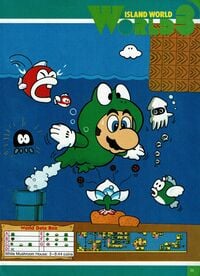
Also referred to as Water Land or Sea Side, Ocean Side is a water-themed region that was raided by Wendy O. Koopa. While some levels take place on solid ground, most of the levels and even one of the worlds two fortresses involve water in a certain way. At the northern part of the world map, Mario will encounter drawbridges that open and close in a set pattern. The world's palace is located far to the east on a small remote island that is only accessible through a Warp Pipe. The king of Ocean Side was turned into a Spike (or a Dino-Rhino from Super Mario World in the remake) during Wendy's attack. A boat can be unlocked by using a Hammer on a rock in the south. Through it, the player can reach some bonus Spade Panels and Toad Houses. Ocean Side contains nine levels in total, of which one can be skipped if a certain drawbridge is closed, and houses several water creatures like Bloopers, Cheep Cheeps, and Big Berthas. The world also introduces a very rare Boo known as a Stretch.
Big Island (Iggy Koopa)
This world, which is also known as Giant Land, is mainly composed of an island in the vague shape of a Koopa. It is a relatively green island with plants growing on it that resemble Fire Flowers. The castle at the west coast of the island was attacked by Iggy Koopa who transformed the Big Island King into an orange dinosaur (or Donkey Kong Jr. in the remake). The world has two fortresses, one on the east side and one on a small island in a lake in the world's center. The most prominent feature of Big Island, which gives this world its name, is the fact that many enlarged versions of regular enemies, blocks, and environmental features can be found here. The world features four Toad Houses, two Spade Panels and six levels, of which five need to be cleared to reach the king's palace.
The Sky (Roy Koopa)
The area also known as Sky Land is the world that has been conquered by Roy Koopa, who has turned its king into a condor (Albatoss in the remake). It is divided into two parts: a ground part and a sky part. The player begins on the ground. The most notably feature of this area is the possibility to gain the Kuribo's Shoe, an item that can be obtained in level 5-3. After clearing the levels on the ground, the player can reach a spiraling tower that reaches up to the sky. The main part of the level is located here, and there are also some creatures exclusively to this realm, namely the Para-Beetle. After clearing the tower that serves as a link between the two areas, the player can go back to the ground, but they will have to clear the tower again on their way up. If Roy Koopa isn't defeated at the first try, his Airship will be able to move freely between sky and ground. There are nine levels in total, three Spade Panels, three Toad Houses and two Fortresses. The palace is on the southwest part of the sky part.
Iced Land (Lemmy Koopa)
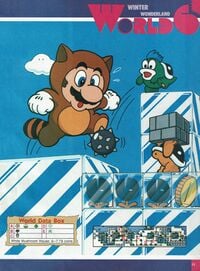
Sometimes referred to as Ice Land, Iced Land is an area covered in snow and ice. The palace of Iced Land was attacked by Lemmy Koopa - who has turned its king into a fur seal (Monty Mole in the remake) and Mario has to venture there and reclaim the magic wand just like in the previous worlds. Before he can reach the palace however, the player has to navigate Mario through the levels of Iced Land. These levels feature frozen ground which makes movement more difficult, as Mario has poor footing on them and is likely to slip off into a bottomless pit. In some levels, the player can find ice blocks that contain coins or enemies. These blocks can only be melted with one of Fire Mario's fireballs. There are ten levels in total, three Spade Panels, two Toad Houses, and three Fortresses. The Palace is far to the east near the sea.
Pipe Maze (Ludwig von Koopa)
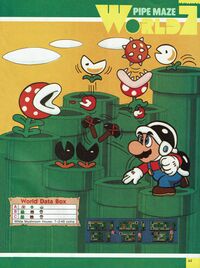
Also known as Pipe Land, Pipe Maze is a series of small islands in a network of confusing pipes. The fourth stage is an underwater level with spiked Cheep Cheeps, some Big Berthas and three Blooper Nannies. Prince Ludwig von Koopa attacked the Pipe Maze king and turned him into a goldenrod Venus Fire Trap (Yoshi in the remakes.) The country itself consists of nine levels, three Spade Panels, two Fortresses, two Nipper Plant Levels and three Toad Houses. The palace is located in southeastern Pipe Maze by the sea. If not defeated, Ludwig's airship will fly from one island to another, since the anchor is required to stop it.
Castle of Koopa (Bowser)
This mysterious world (also known as Dark Land) is ruled by King Bowser. The levels in this world are primarily tank brigades and airships. There are also Hand Traps found in the second area of the world, which unexpectedly grab Mario or Luigi and take them to a short obstacle course which has a chest containing a Super Leaf at the end. The third area has two normal levels and a Fortress, and the final level has the last tank level and Bowser's Castle, where Mario or Luigi must finally battle Bowser.
Warp Zone
World 9 is only accessible by a Warp Whistle. In it, the player can choose to go to any other world in the game. The selection of worlds the player can choose from changes depending on the world they used the Warp Whistle in. If the player uses another Warp Whistle in the Warp Zone, it will take them to the pipe leading to World 8.
World-e
World-e is an e-Reader-based world, and it is exclusive to Super Mario Advance 4: Super Mario Bros. 3. It can be reached right at the very beginning of the game. Players can use two Game Boy Advance, one with the game and the other with the e-Reader in order to scan level cards, demo cards, and power-up cards.
Gameplay
Controls
While in a Level
: Move
/
 : Jump
: Jump/
 : Dash/interact
: Dash/interact/
: Pause
On the World Map
: Move Mario Around the Map.
/
 : Select level/item
: Select level/item/
 : Open the item menu
: Open the item menu
Power-Ups
| Small Mario | File:SMB3 Smallmario.svg | Mario's weakest form used when a new game begins. If Mario touches an enemy while in this form, he loses a life. |
|---|---|---|
| Super Mario | File:Super Mario SMB3.PNG | The form Mario turns into after obtaining a Super Mushroom in small form. Mario gains the ability to break Brick Blocks in this state. If Mario touches an enemy while in this form, he shrinks back to his small form. |
| Fire Mario | File:Fire Mario SMB3.PNG | After utilizing a Fire Flower, Mario will turn into Fire Mario, giving him the ability to defeat enemies by shooting fireballs at them. |
| Invincible Mario | File:RainbowMario.gif | After getting a Starman, Mario will become invincible, and cannot be harmed by any enemies or obstacles. Along with the bonus of invincibility, Mario can also defeat most enemies without jumping on or throwing projectiles at them. This will only last for a short period of time, and Mario will still lose a life if he falls into an abyss or lands in a pool of lava. |
| Raccoon Mario | File:Raccoon Mario SMB3.PNG | After using the Super Leaf, Mario will transform into Raccoon Mario. In this state, Mario can spin his tail to attack most enemies, and he can also fly for a short period of time after gaining enough speed. |
| P-Wing | The P-Wing looks and behaves similarly to the Raccoon Suit, but includes a large "P" on Mario's chest and allows for indefinite flight. After a level is cleared with this form, Mario will transform back into Raccoon Mario. | |
| Hammer Mario | File:Hammer Mario SMB3.PNG | Upon obtaining the Hammer Suit, Mario will turn into Hammer Mario. In this state, Mario can defeat enemies by throwing hammers, and can shield himself from fireballs by using his shell, but cannot slide down hills. |
| Frog Mario | File:Frog Mario SMB3.PNG | Mario will turn into Frog Mario after retrieving the Frog Suit. The Frog Suit allows Mario to swim much easier, but impedes his movement on land drastically. |
| Tanooki Mario | File:Tanooki Mario SMB3.PNG | After obtaining the Tanooki Suit, Mario transforms into Tanooki Mario. Along with the abilities to fly and attack with his tail, Mario can turn into a statue to confuse his enemies for a short period of time. |
| Shoe Mario | File:Kuribo Mario SMB3.PNG | Only obtainable in World 5-3 of the game, the Goomba's Shoe allows Mario to safely hop across dangerous objects and jump on spiky enemies, such as Piranha Plants and Spinies. It is obtained from attacking a Goomba hopping in the shoe from below. It is only found in this game with the exception of remakes. |
In international releases, after players obtain a power-up that is greater than a Super Mushroom, any injury will turn them back to their super form. In the original Japanese NES release, any hit reduces the player back to small form, much like the original Super Mario Bros.
Enemies
- Battle Mode
- Goombas
- Koopas
- Buzzies
- Piranha Plants
- Lakitu
- Hammer Brothers
- Fortress
- Water
- Baby Bloober
- Baby Cheep
- Big Bertha
- Bloober
- Bloober Nanny
- Boss Bass
- Cheep-Cheep
- Jelectro
- Lava Lotus
- Spiny Cheep-Cheep
- Desert
- Chomps
- Artillery
- Bill Blaster
- Bob-omb
- Bullet Bill
- Cannon
- Cannonball
- Giant Cannonball
- Missile Bill
- Rocket Engine
- Rocky Wrench
Bosses
2-Player
In two-player mode, player one is Mario, and player two is Luigi. After one brother completes a level/loses a life, the other brother plays. Also, if one brother picks a level that the other brother completed, they enter versus mode in their small forms.
Some versus mode stages are similar to Mario Bros. The player that defeats three of five enemies or survives wins. Enemies to defeat are Spinies, Sidesteppers, and Fighter Flies but defeating a Fireball does not count. Players can indirectly kill each other by forcing the rival to collide with an enemy to gain victory. Players can also steal Roulette Box cards from each other by bumping from below. One stage involves grabbing three of five coins.
There is also a stage that has a vertical pipe that shoots out Fireballs and coins. The player that collects three coins or survive wins. Another stage has the players climbing ladders to retrieve coins under boxes, some of which are empty. The first to obtain three wins.
Any deaths incurred in the versus mode will not affect the player's lives in the main game. Super Mario All-Stars also includes a similar Battle Game in the main menu for Super Mario Bros 3.
Development
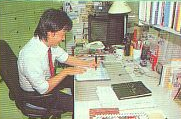
The hard part of creating a video game with old characters is making the old characters seem fresh and new.[1][2]In many ways, Super Mario Bros. 3 revived the series and brought many new young and old fans back to the adventures of the Mario Bros..
Remakes and Ports
Super Mario Bros. 3 was later revamped and included in Super Mario All-Stars, with updated graphics and sound for the Super Nintendo Entertainment System, as well as in the re-issue, Super Mario All-Stars + Super Mario World, and the game's eventual port to the Wii as Super Mario All-Stars Limited Edition. A notable addition to the All-Stars version of Super Mario Bros. 3 was a save feature. Additionally, there's a Battle Game feature that works differently from the ones featured from the maps in the 2-Player Game Mode. Other than that and certain glitches fixed, gameplay was not changed.
Super Mario Advance 4: Super Mario Bros. 3
In 2003, the fourth entry in the Super Mario Advance series, Super Mario Advance 4: Super Mario Bros. 3, known in Japanese as スーパーマリオアドバンス 4 (Sūpā Mario Adobansu 4) was released for the Game Boy Advance. It boasted similar graphics and sound to the Super Mario All-Stars version, and made use of the e-Reader. A few e-cards came included with new copies of the game, while two sets (referred to as "series") of cards, were released and sold alongside the game. By scanning special cards into the e-Reader, players were able to upload items, videos, and most importantly, new levels into game. One notable item was the Cape Feather from Super Mario World, which allowed Mario to transform in Cape Mario. There were also two Switch cards that the player could activate (and deactivate) the effects of by scanning them; the Orange Switch and the Blue Green Switch. Scanning these switches triggered small functions in the game. The e-Reader feature is still available in the European version, but disabled by default and inaccessible. It is fully translated, probably because the e-Reader was planned to be released in Europe. It can be "unlocked" by having a corrupted save file.[3]
Story
The story, from the instruction booklet:
The Mushroom Kingdom has remained a peaceful place, thanks to the brave deeds of Mario and Luigi. However, the Mushroom Kingdom forms an entrance to the Mushroom World, a place where all is not well. Bowser sent his seven children to make mischief in this normally peaceful land. As their first order of business, they stole the royal magic wands from each country in the Mushroom World and used them to turn the Mushroom Kings into animals. Mario and Luigi must recover the royal magic wands from Bowser's seven kids to return the kings to their true forms. As Mario and Luigi set off on their journey deep into the Mushroom World, Princess Peach and Toad have but one thing to say: "Good-bye, and good luck!"
List of Changes
There are many changes between the original Super Mario Bros. 3 and Super Mario Advance 4.
Gameplay changes:
- Getting a Fire Flower or Raccoon Leaf when Mario is small will have their usual effect rather than work as a Mushroom.
- Koopa Troopas can now be stomped underwater.
- Upside-down Spiny shells can now be safely touched, stomped or kicked from above without taking damage; in previous versions, even an immobile, upside-down Spiny shell would hurt Mario if he landed on top of it.
- Giant Brick Blocks can now be broken with Mario's tail (with the Raccoon or Tanooki suit).
- In several levels of Big Island, just before the Goal Panel, there is a coin bonus in the sky.
- Spade Panels now produce different variants in response to completing one. The order is: Spade > Heart > Club > Diamond. Each one allows the player the chance to earn more lives.
- Mario can have more than 100 lives.
- In The Sky, some brick blocks that otherwise make Pipes and Bullet Bill cannons float in the air contain coins.
- In Iced Land, the path to the Mushroom House was altered so the player does not have to do 6-5 to access it.
- Mario can carry shells into pipes without losing them.
- Some enemies are changed. For example, the first pipe in level 1-1 now contains a normal Piranha Plant instead of a Venus Fire Trap.
- One cannon was removed from the World 8 Battleship level.
- The first tank level in World 8 is shorter, with the removal of the first two tanks after the first ? block. Similar things were done in the World 8 Airship.
- Hammer Mario can now slide down hills.
- Pressing the R button brings up the e-Reader menu.
- Several platforms throughout the game were made longer.
Aesthetical changes:
- Before facing Boom-Boom, steel blocks will block the entrance.
- New music plays when in a Bonus Area.
- In World 4, the map icon for the Sledge Bro. got modified to make it look more like an actual Sledge Brother. Their SNES map icon was merely a green Hammer Brother.
- In World 5, the map of the ground seen from the sky was moved up and right hiding the little mistake they made on the "Ground Map" on the NES and SNES Version.
- Shooting a fireball at Bowser causes him to turn red for an instant.
- A few sprites were slightly improved. For example Mario and Luigi now wear their gloves. Previous versions had the two with no visible gloves, the NES version due to color limitations and the All-Stars version because Nintendo forgot to change it.
- Princess Peach received a brand new sprite for the Game Boy Advance version.
- For most levels (except for underground levels, airships, and fortresses) there is no parallax scrolling in the background.
- The cards acquired at the end of each level have been renamed "panels".
- The inventory window is now much larger.
- Sprites now have a slightly brighter color, but not as noticeable as the other Super Mario Advance games.
- Mushroom Kings have slightly different speeches. They start out with "Oh, splendid! Splendid!" rather than "Oh, thank heavens!"; "I'm" was changed to "I am"; and the word "Princess" no longer has improper capitalization.
- World 8's name was changed from "Castle of Koopa" to "Bowser's Castle".
- When entering part 2 of the World 8 map, Princess Toadstool is shown above the second pipe. She shouts, "Mario!" and then appears to enter the pipe.
- Using a Warp Whistle in GBA causes the screen to blur out. In either NES or SNES, nothing would happen to the screen.
- If the player warps to World 8, Bowser's letter will appear on screen.
e-Reader Cards
For a complete listing of the cards themselves, see Super Mario Advance 4 e-Cards, however here is a list of additional features added to Super Mario Advance 4 by the cards:
Exclusive Features
- See-saw platforms
- Grey Brick Blocks (Can only be destroyed by Hammer Suit or crushed by Tanooki Mario's statue)
- ! Switch
- Rotating Blocks
- Sideways Venus Fire Trap
- Ace Coins
- E+ Coins
- Invisible Blocks (can be visible when Mario transforms into the Tanooki Mario statue)
- ? Block with Goomba's Shoe
- Grey spike Donut Lifts
- Blue Boomerang
Features and Enemies from Past Titles
- Super Mario Bros.
- Lifts
- Firebars
- Balance platforms
- False Bowser
- Super Mario Bros. 2
- Vegetables
- Sand able to be dug
- POW Blocks
- Locked doors
- Hoopsters
- Flurries
- Porcupos
- Super Mario World
- Cape Feather/Cape Mario
- Stretch Blocks
- Triangular Blocks
- Snake Blocks
- Trampolines
- Roulette Blocks
- 3-Up Moon
- Keys
- Spike Tops
- Cross-shot Bullet Bills
- Lil' Sparkies
- Hotheads
- Bony Beetles
- Thwimps
- Magikoopas
- Amazing Flying Hammer Bros.
- Rip Van Fish
- Jumping Piranha Plants
- Monty Moles
- Wigglers
- Round Goombas
- Para-Goombas
- Gray Bowser Statues
- Gold Bowser Statues
- Falling Spikes
- Big Boos
- The Big Boo
- Chargin' Chuck
- ? Blocks with Coin Snakes
- Super Mario World 2: Yoshi's Island
- One-way gates
- Bumpties
- Super Mario Advance
- Giant Vegetables
- Items trapped in bubbles
Blurb
Taken straight from the game box.
American version (e-Reader cards bundle)
THE MARIO BROS. AT THEIR BEST!
The best-selling game of all time has arrived for Game Boy Advance,
now with all-new features!
- Mario's not alone! This time around,
Luigi can get in on the action! - Use wild power-ups like the Super Leaf and the
Frog and Tanooki Suits! - Link up with any Super Mario Advance
game for multiplayer Mario Bros. madness!
Nintendo e-Reader
Even more Mario fun is in the cards!
Link up and use an e-Reader and special
cards to add classic and updated
Mario levels, all-new levels, and
incredibly hard "SUPER" levels, that you
can save to your Game Pak. There are
also power-up cards, demo cards with
pro techniques, and much more!
(e-Reader and e-Reader cards sold separately.)
- Bonus Level Card
and Power-up
Card included! - Add new levels using the e-Reader
and Level Cards (sold separately)!
European version
Following text taken from the English part.
Mario & Luigi to the rescue! The seven cruel children of Bowser have transformed all of the Kings of Mushroom
World into animals. Help Mario and Luigi to regain the Magic Wands that have the power to restore the kings.
Experience this renowned classic NES game in its extended version, as you battle your way throught over 80 levels of exquisite
platfrom action. Additionally, you can link up with any Super Mario Advance game for multiplayer Mario Bros. madness!
Beta elements
Boxart
Reception
The game has recieved positive reviews. IGN gave the game 1st place in their Top 100 NES Games list[4].
Media
References to Other Games
- Mario Bros.- The Battle Mode is very similar to the multiplayer in this game.
- Super Mario Bros.- When Toadstool is saved from Bowser, she says "Thank you. But our Princess is in another castle! ...Just kidding! Ha ha ha! Bye bye." This is a reference to the Mushroom Retainer's line "Thank you Mario, but our princess is in another castle!" from this game. This does not happen for the GBA version because the message was changed.
- Super Mario Bros. 2- Princess Toadstool's appearance is identical to how she appeared in this game.
References in Later Games
- Super Mario All-Stars and Super Mario All-Stars + Super Mario World - This contains a remake of Super Mario Bros. 3.
- Super Mario RPG: Legend of the Seven Stars - The music heard in Grate Guy's Casino is a rendition of music from the Mini-Games of Super Mario Bros 3, and the theme heard during the battle with Bowser in Super Mario RPG is a remix of that from Super Mario Bros. 3.
- Paper Mario - The jingle that plays when Mario rescues a Star Spirit is a remix of the theme that plays when Mario recovers a Mushroom King's Magic Wand.
- Mario Party Advance - The music played after Mario beats a Boom Boom/Koopaling is heard after the player completes a quest. Also, in the mini-game Drop 'em, the background has a similar design to the levels from Super Mario Bros. 3.
- Tetris DS- Levels 4, 5 and 6 in Marathon mode uses Super Mario Bros. 3 gameplay on the top screen, along with the Raccoon, Frog and Tanooki Mario sprites on the touch screen. Also, a remix of the overworld theme plays.
- Dance Dance Revolution: Mario Mix - Music from Super Mario Bros. 3 is remixed in this game.
- Super Mario 64 - Many levels in Big Island resemble Tiny-Huge Island in Super Mario 64 and its remake. Changing sizes by using doors also resembles using pipes to go from tiny to huge in Tiny-Huge Island.
- WarioWare: Twisted! - The Super Mario Bros. 3 microgame, along with the Super Mario Bros. 3-Lift microgame, are based on Super Mario Bros. 3.
- Super Smash Bros. Melee - The main overworld theme was remixed in both Mushroom Kingdom and Princess Peach's Castle.
- Super Mario 64 DS - The Rec Room theme is a remix of the Grass Land theme
- New Super Mario Bros. - Many concepts started in here are features in this game, such as Toad Houses. A lot of the worlds have similar themes. Plus, the fortress theme is remixed.
- Super Paper Mario - The theme that plays when Big Blooper appears is a remix of the underwater theme from Super Mario Bros. 3.
- Super Smash Bros. Brawl - The main overworld theme from Super Smash Bros. Melee is re-used in this game.
- Mario Kart Wii - A license plate which reads "SMB3" can be found.
- Super Mario Galaxy - The airship and athletic music is remixed in this game.
- New Super Mario Bros. Wii - The Penguin Suit is based on the suits of Super Mario Bros. 3. The Koopalings' battle theme is remixed twice and once again played when fighting against them. The airship theme is remixed, and can be heard on airship levels. The design on the fortresses are based on the fortress sprites of Super Mario Bros. 3. The Enemy Courses are similar to the levels when fighting against a Hammer Bro., Fire Bro., Boomerang Bro., or Sledge Bro., and even use a remix of the song. Also, players can use reserve power-ups like in Super Mario Bros. 3. Also, the Parabeetle makes its second and only other appearance in the main games so far here.
- Super Mario 3D Land - The Tanooki Suit, Jump Blocks, and the Super Leaf appear in this game. Also the Airships and Boom Boom battles returns.
- New Super Mario Bros. 2 - Some levels contain the same colourful blocks from this game. Also, Raccoon Mario, the Super Leaf and Jump blocks return, along with the Koopalings.
Beta elements
- Main article: Super Mario Bros. 3/Beta elements
Glitches
- Main article: Super Mario Bros. 3/Glitches
Gallery
Quotes
- "The Tanooki Suit turns into a statue! Even though I knew it wouldn't make sense to some non-Japanese players...I was so excited about it that I left it in." - Shigeru Miyamoto, Super Mario History 1985-2010 booklet
- "We were helped by many people when developing this game. But even with a larger team, I was still the worst gamer of the bunch." - Takashi Tezuka, Super Mario History 1985-2010 booklet
- "This time around, I added a lot of percussion and was able to create tracks that sounded like there were three or more sounds playing at once, resulting in much richer-sounding music." - Koji Kondo, Super Mario History 1985-2010 booklet
Trivia
- This marked the first appearance of important characters or species, such as the Koopalings, Boos, Paragoombas, Dry Bones, Thwomps, Venus Fire Traps and Chain Chomps.
- The Nintendo Entertainment System version of the game was released twice in English. In the re-release, the names of the worlds were changed to (theme of world) Land, while the first English version used the original Japanese names. Other changes include a slightly different set of instructions from Toad's N-Spade game and a slight rewrite in one of Toadstool's letters, changing "Kuribo's Shoe" to "Goomba's Shoe".
- Defeating a boss while in the Frog, Hammer or Tanooki suit results in an alternate message from the newly transformed king.
- According to the Guinness Book of World Records 2008, Super Mario Bros. 3 was the world's best-selling video game, which is false.
- However, the image used in the book was of Super Mario Advance 4: Super Mario Bros. 3, the remake, which made the same mistake on the back of the box.
- Along with Yoshi's Island: Super Mario Advance 3, Super Mario Advance 4: Super Mario Bros. 3 is the only Super Mario Advance game with Italian localisation.
- Fire Mario's cap and shirt were orange in both the official illustration of Desert Hill and in the original NES version of the game; however, later versions of Super Mario Bros. 3 changed the orange to white.
- It was first shown in the 1989 movie The Wizard to advertise the game, this also marked the first time that a mario game was advertised in a movie.
- In the NES version of the game, the sprite for Fire Mario and Fire Luigi is nearly identical to the sprite seen when Mario and Luigi are powered up by the Starman in the original Super Mario Bros. game and when they power up shortly after obtaining a Fire Flower. In Super Mario Bros., that sprite wears a red hat, an orange shirt, red pants and orange shoes, while in Super Mario Bros. 3, the sprite retains the same clothing except it wears an orange hat instead of a red one.
References
External links
- Program Details for Super Mario Bros. 3 - Time Attack
- Nintendo Power Special: The making of Super Mario Bros. 3
- The Mushroom Kingdom - Beta elements in Super Mario Bros. 3
Template:BoxTop Template:Mariogames Template:Super Mario Bros. 3

